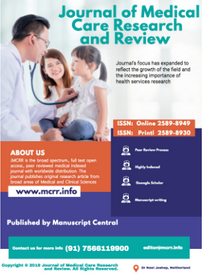Abstract
Background: Recurrent lumbar disc herniation (RLDH) is one of the most common spinal disorders following dise surgery. It is a major disabling condition as it impairs significantly with daily activities. But the management of recurrent lumbar disc herniation remains still controversial. Aim: To evaluate the recurrent lumbar disc herniation in results of revision discectomy to postoperative status. Methods: This prospective interventional study was conducted in department of Orthopaedic Surgery, BSMMU, Dhaka from October 2017 to September 2019. A total of 22 cases of RLDH having the inclusion criteria were taken as sample after diagnosing clinically, radiologically and with MRI. Outcome of low back pain (LBP) and radicular pain was measured by visual analogue score (VAS) and overall clinical outcome by Japanese Orthopaedic Association (JOA) score. Statistical analysis was done by using statistical package for social science (SPSS-25). The results were expressed as frequency, percentage and mean ± SD. Level of significance was calculated at confidence interval of 95% and p< 0.05.
Results: Follow up period was at least 06 months. Age of patients ranges from 35-70 years with mean age 51.1±19.7 years; 68.2% were male and 31.8% were female. Heavy workers were 54.5%, light workers 18.2% and house wives 27.3% with L4-L5 level involvement in 54.5% patients and L5-S1 in 45.5% patients. 77.3% subjects had BMI >30 kg/m² and 22.7% had ≤30 kg/m² with mean BMI 31.2±1.5 kg/m². In this study, Tobacco, diabetes and hypertension were found highly associated with recurrent disc herniation. 14 (63.6%), 11 (50%) and 13 (59.1%) patients were found as tobacco users, diabetic and hypertensive. In this study, interval between primary discectomy and RLDH was 6-12 months in 8 (36.4%) patients, 13-24 months in 10(45.45%), 25-36 months in 3(13.64%) and >36 months in 1(4.55) patient with mean interval 17.18±8.47 months. Majority (77.3% and 54.5%) of the study subjects had preoperative VAS score 7-10 and postoperative VAS score was 1 to 3 respectively. Pre and postoperative mean (+ SD) VAS score was 7.86±1.36 and 2.77±1.86 respectively. This indicated a significant difference between the two groups. Majority (72.7% and 63.2%) of the study subjects had preoperative VAS score 7-10 and postoperative VAS score was 1 to 3 respectively. Pre and postoperative mean (+ SD) VAS score was 7.5911.64 and 1.95+1.65 respectively. This indicated a significant difference between the two groups. In this study, only 4 (18.18%) patients developed postoperative complications. Among them, 1(4.55%) patient developed postoperative instability, 1 (4.55%) patient developed dural tear & transient neurological deficit and 2 (9.09%) patients developed postoperative superficial wound infection.To determine the surgical outcome of the study, excellent and good grades were treated as satisfactory, fair and poor grades were treated as unsatisfactory. So, a total number of 20 (90.9%) patients were in the satisfactory group and only 2 (9.1%) patients were in the unsatisfactory group. Conclusions: After analyzing the results of present study, it can be concluded that revision discectomy is an effective procedure with very satisfactory functional results for management of patients with recurrent lumbar disc herniation.
Full text article
References
Suk KS, Lee HM, Moon SH, Kim NH. 2001. Recurrent lumbar disc herniation: results of operative management. Spine. 26:672-676.
Kim KT, Park SW, Kim YB 2009. Disc height and segmental motion as risk factors for recurrent lumbar disc herniation. Spine. 34: 2674-2678.
El Shazly AA, El Wardany MA, Morsi AM. 2013. Recurrent lumbar disc herniation: A prospective comparative study of three surgical management procedures. Asian J Neurosurg. 8: 139-146.
Shimia M, Babaei-Ghazani A, Sadat BE, Habibi B, Habibzadeh A. 2013. Risk factors of recurrent lumbar disk herniation. Asian J Neurosurg. 8: 93-96.
Khayat R, Khallaf M, Hassan HM, Gamal M. 2017. Evaluation of treatment of recurrent lumbar disc prolapse: fusion versus non Fusion. International Annals of Medicine; 1(9): 1-7.
Omidi-Kashani F, Hasankhani EG, Zare A. 2016. Prognostic value of impaired preoperative ankle reflex in surgical outcome of lumbar disc herniation.Arch Bone JtSurg. 4(1): 52-55.
Hakkinen A, Kiviranta I, Neva MH, Kautianen H, Ylinen J. 2007. Reoperations after first lumbar disc herniation surgery: A special interest on residives during a 5 year follow-up. BMC Musculoskeletal disorder. 8(2): 1-6.
Papadopoulos EC, Girardi FP, Sandhu HS. 2006. Outcome of revision discectomies following recurrent lumbar disc herniation. Spine. 31: 1473-1476.
Patel MS, Braybrooke J, Newey M, Sell P. 2013. A comparative study of the outcomes of primary and revision lumbar discectomy surgery. Bone Joint J. 95(B): 90-94.
Cinotti G, Rosyam GS, Eisenstein SM, Postacchini F. 1998. Ipsilateral recurrent lumbar disc herniation: a prospective, controlled study. J Bone Joint Surg Br. 80: 825- 832.
Fu TS, Lai PL, Tsai TT, Niu CC, Chen LH, Chen WJ. 2005. Long-termresults of disc excision for recurrent lumbar disc herniation with or without posterolateral fusion. Spine. 30: 2830-2834.
Khattak AU, Haider A, Rehman L, Mushtaq I. 2009. Surgical outcome of recurrent lumbar disc herniation: experience with 30 patients. JPMI. 23(1): 86-89.
Mashhadinezhad MH, Sarabi ME, Mashhadinezhad MS, Ganjeifar MB. 2018. Clinical outcomes after microdiscectomy for recurrent lumbar disk herniation: a single-center study. Arch Bone JtSurg; 6(5): 397-401.
Meredith DS, Huang RC, Nguyen J, Lymas S. 2010. Obesity increases the risk of recurrent herniated nucleus pulposus after lumbar microdiscectomy. Spine J. 10: 575- 580.
Mobbs RJ, Newcombe RL, Chandran KN. 2001. Lumbar discectomy and the diabetic patient: incidence and outcome. J ClinNeurosci. 8: 10-13.
Miwa S, Yokogawa A, Kobayashi T. 2015. Risk factors of recurrent lumbar disc herniation: a single center study and review of the literature. J Spinal Disord Tech. 28: 265-269.
Aghayee HN, Azhari S, Heidarnejad F. 2014. The outcomes of surgical treatment of recurrent lumbar disk herniation with discectomy alone and discectomy with posterolateral interbody fusion. Novel Biomed. 2(1): 10-17.
Ibrahim M, Arockiaraj J, Amritanand R, Venkatesh K, David KS. 2015. Recurrent lumbar disc herniation: Results of revision surgery and assessment of factors that may affect the outcome. A non-concurrent prospective study. Asian Spine J. 9(5): 728-736.
Shepard N, Cho W. 2017. Recurrent Lumbar Disc Herniation: A Review. Global Spine Journal. 1-8.

